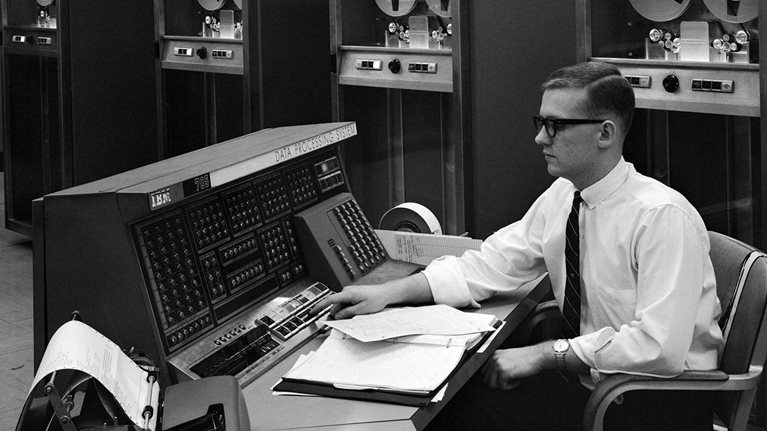In a 1967 McKinsey Quarterly article, “The manager and the moron,” Peter Drucker noted that “the computer makes no decisions; it only carries out orders. It’s a total moron, and therein lies its strength. It forces us to think, to set the criteria. The stupider the tool, the brighter the master has to be—and this is the dumbest tool we have ever had.”1
How things have changed. After years of promise and hype, machine learning has at last hit the vertical part of the exponential curve. Computers are replacing skilled practitioners in fields such as architecture, aviation, the law, medicine, and petroleum geology—and changing the nature of work in a broad range of other jobs and professions. Deep Knowledge Ventures, a Hong Kong venture-capital firm, has gone so far as to appoint a decision-making algorithm to its board of directors.
What would it take for algorithms to take over the C-suite? And what will be senior leaders’ most important contributions if they do? Our answers to these admittedly speculative questions rest on our work with senior leaders in a range of industries, particularly those on the vanguard of the big data and advanced-analytics revolution. We have also worked extensively alongside executives who have been experimenting most actively with opening up their companies and decision-making processes through crowdsourcing and social platforms within and across organizational boundaries.
Our argument is simple: the advances of brilliant machines will astound us, but they will transform the lives of senior executives only if managerial advances enable them to. There’s still a great deal of work to be done to create data sets worthy of the most intelligent machines and their burgeoning decision-making potential. On top of that, there’s a need for senior leaders to “let go” in ways that run counter to a century of organizational development.
If these two things happen—and they’re likely to, for the simple reason that leading-edge organizations will seize competitive advantage and be imitated—the role of the senior leader will evolve. We’d suggest that, ironically enough, executives in the era of brilliant machines will be able to make the biggest difference through the human touch. By this we mean the questions they frame, their vigor in attacking exceptional circumstances highlighted by increasingly intelligent algorithms, and their ability to do things machines can’t. That includes tolerating ambiguity and focusing on the “softer” side of management to engage the organization and build its capacity for self-renewal.
Missing links
The most impressive examples of machine learning substituting for human pattern recognition—such as the IBM supercomputer Watson’s potential to predict oncological outcomes more accurately than physicians by reviewing, storing, and learning from reams of medical-journal articles—result from situations where inputs are of high quality. Contrast that with the state of affairs pervasive in many organizations that have access to big data and are taking a run at advanced analytics. The executives in these companies often find themselves beset by “polluted” or difficult-to-parse data, whose validity is subject to vigorous internal debates.
This isn’t an article about big data per se—in recent Quarterly articles we’ve written extensively on what senior executives must do to address these issues—but we want to stress that “garbage in/garbage out” applies as much to supercomputers as it did 50 years ago to the IBM System/360.2 This management problem, which transcends CIOs and the IT organization, speaks to the need for a turbocharged data-analytics strategy, a new top-team mind-set, fresh talent approaches, and a concerted effort to break down information silos. These issues also transcend number crunching; as our colleagues have explained elsewhere, “weak signals” from social media and other sources also contain powerful insights and should be part of the data-creation process.3
The incentives for getting this right are large—early movers should be able to speed the quality and pace of decision making in a wide range of tactical and strategic areas, as we already see from the promising results of early big data and analytics efforts. Furthermore, early movers will probably gain new insights from their analysis of unstructured data, such as e-mail discussions between sales representatives or discussion threads in social media. Without behavioral shifts by senior leaders, though, their organizations won’t realize the full power of the artificial intelligence at their fingertips. The challenge lies in part with the very notion that machine-learning insights are at the fingertips of senior executives.
That’s certainly an appealing prospect: customized dashboards full of metadata describing and synthesizing deeper and more detailed operational, financial, and marketing information hold enormous power for the senior team. But these dashboards don’t create themselves. Senior executives must find and set the software parameters needed to determine, for instance, which data gets prioritized and which gets flagged for escalation. It’s no overstatement to say that these parameters determine the direction of the company—and the success of executives in guiding it there; for example, a bank can shift the mix between lending and deposit taking by changing prices. Machines may be able to adjust prices in real time, but executives must determine the target. Similarly, machines can monitor risks, but only after executives have determined the level of risk they’re comfortable with.
Consider also the challenge posed by today’s real-time sales data, which can be sliced by location, product, team, and channel. Previous generations of managers would probably have given their eyeteeth for that capability. Today’s unaware executive risks drowning in minutiae, though. Some are already reacting by distancing themselves from technology—for instance, by employing layers of staffers to screen data, which gets turned into more easily digestible Power Point slides. In so doing, however, executives risk getting a “filtered” view of reality that misses the power of the data available to them.
As artificial intelligence grows in power, the odds of sinking under the weight of even quite valuable insights grow as well. The answer isn’t likely to be bureaucratizing information, but rather democratizing it: encouraging and expecting the organization to manage itself without bringing decisions upward. Business units and company-wide functions will of course continue reporting to the top team and CEO. But emboldened by sharper insights and pattern recognition from increasingly powerful computers, business units and functions will be able to make more and better decisions on their own. Reviewing the results of those decisions, and sharing the implications across the management team, will actually give managers lower down in the organization new sources of power vis-à-vis executives at the top. That will happen even as the CEO begins to morph, in part, into a “chief experimentation officer,” who draws from acute observance of early signals to bolster a company’s ability to experiment at scale, particularly in customer-facing industries.
We’ve already seen flashes of this development in companies that open up their strategy-development process to a broader range of internal and external participants. Companies such as 3M, Dutch insurer AEGON, Red Hat (the leading provider of Linux software), and defense contractor Rite-Solutions have found that the advantages include more insightful and actionable strategic plans, as well as greater buy-in from participants, since they helped to craft the plan in the first place.4
In a world where artificial intelligence supports all manner of day-to-day management decisions, the need to “let go” will be more significant and the discomfort for senior leaders higher. To some extent, we’re describing a world where top executives’ sources of comparative advantage are eroding because of technology and the manifested “brilliance of crowds.” The contrast with the command-and-control era—when holding information close was a source of power, and information moved in one direction only, up the corporate hierarchy—could not be starker. Uncomfortable as this new world may be, the costs of the status quo are large and growing: information hoarders will slow the pace of their organizations and forsake the power of artificial intelligence while competitors exploit it.
The human edge
If senior leaders successfully fuel the insights of increasingly brilliant machines and devolve decision-making authority up and down the line, what will be left for top management to do?
Asking questions
A great deal, as it turns out—starting with asking good questions. Asking the right questions of the right people at the right times is a skill set computers lack and may never acquire. To be sure, the exponential advances of deep-learning algorithms mean that executive expertise, which typically runs deep in a particular domain or set of domains, is sometimes inferior to (or can get in the way of) insights generated by deep-learning algorithms, big data, and advanced analytics. In fact, there’s a case for using an executive’s domain expertise to frame the upfront questions that need asking and then turning the machines loose to answer those questions. That’s a role for the people with an organization’s strongest judgment: the senior leaders.
The importance of questions extends beyond steering machines, to interpreting their output. Recent history demonstrates the risk of relying on technology-based algorithmic insights without fully understanding how they drive decision making, for that makes it impossible to manage business and reputational risks (among others) properly. The potential for disaster is not small. The foremost cautionary tale, of course, comes from the banks prior to the 2008 financial crisis: C-suite executives and the managers one and two levels below them at major institutions did not fully understand how decisions were made in the “quant” areas of trading and asset management.
Algorithms and artificial intelligence may broaden this kind of analytical complexity beyond the financial world, to a whole new set of decision areas—again placing a premium on the tough questions senior leaders can ask. Penetrating this new world of analytical complexity is likely to be difficult, and an increasingly important role for senior executives may be establishing a set of small, often improvisatory, experiments to get a better handle on the implications of emerging insights and decision rules, as well as their own managerial styles.
Attacking exceptions
An increasingly important element of each leader’s management tool kit is likely to be the ability to attack problematic “exceptions” vigorously. Smart machines should get better and better at telling managers when they have a problem. Early evidence of this development is coming in data-intensive areas, such as pricing or credit departments or call centers—and the same thing will probably happen in more strategic areas, ranging from competitive analysis to talent management, as information gets better and machines get smarter. Executives can therefore spend less time on day-to-day management issues, but when the exception report signals a difficulty, the ability to spring into action will help executives differentiate themselves and the health of their organizations.
Senior leaders will have to draw on a mixture of insight—examining exceptions to see if they require interventions, such as new credit limits for a big customer or an opportunity to start bundling a new service with an existing product—and inspiration, as leaders galvanize the organization to respond quickly and work in new ways. Exceptions may pave the way for innovation too, something we already see as leading-edge retailers and financial-services firms mine large sets of customer data.
Tolerating ambiguity
While algorithms and supercomputers are designed to seek answers, they are likely to be most definitive on relatively small questions. The bigger and broader the inquiry, the more likely that human synthesis will be central to problem solving, because machines, though they learn rapidly, provide many pieces without assembling the puzzle. That process of assembly and synthesis can be messy and slow, placing a fresh premium on the senior leaders’ ability to tolerate ambiguity.
A straightforward example is the comfort digitally oriented executives are beginning to feel with a wide range of A/B testing to see what does and does not appeal to users or customers online. A/B testing is a small-scale version of the kind of experimentation that will increasingly hold sway as computers gain power, with fully fledged plans of action giving way to proof-of-concept (POC) ones, which make no claim to be either comprehensive or complete. POCs are a way to feel your way in uncertain terrain. Companies take an action, look at the result, and then push on to the next phase, step by step.
This necessary process will increasingly enable companies to proceed without knowing exactly where they’re going. For executives, this will feel rather like stumbling along in the dark; reference points can be few. Many will struggle with the uncertainty this approach provokes and wrestle with the temptation to engineer an outcome before sufficient data emerge to allow an informed decision. The trick will be holding open a space for the emergence of new insights and using subtle interventions to keep the whole journey from going off the cliff. What’s required, for executives, is the ability to remain in a state of unknowing while constantly filtering and evaluating the available information and its sources, tolerating tension and ambiguity, and delaying decisive action until clarity emerges. In such situations, the temptation to act quickly may provide a false sense of security and reassurance—but may also foreclose on potentially useful outcomes that would have emerged in the longer run.
Employing ‘soft’ skills
Humans have and will continue to have a strong comparative advantage when it comes to inspiring the troops, empathizing with customers, developing talent, and the like. Sometimes, machines will provide invaluable input, as Laszlo Bock at Google has famously shown in a wide range of human-resource data-analytics efforts. But translating this insight into messages that resonate with organizations will require a human touch. No computer will ever manage by walking around. And no effective executive will try to galvanize action by saying, “we’re doing this because an algorithm told us to.” Indeed, the contextualization of small-scale machine-made decisions is likely to become an important component of tomorrow’s leadership tool kit. While this article isn’t the place for a discourse on inspirational leadership, we’re firmly convinced that simultaneous growth in the importance of softer management skills and technology savvy will boost the complexity and richness of the senior-executive role.
How different is tomorrow’s effective leader from those of the past? In Peter Drucker’s 1967 classic, The Effective Executive, he described a highly productive company president who “accomplished more in [one] monthly session than many other and equally able executives get done in a month of meetings.” Yet this executive “had to resign himself to having at least half his time taken up by things of minor importance and dubious value … specific decisions on daily problems that should not have reached him but invariably did.”5 There should be less of dubious value coming across the senior executive’s desk in the future. This will be liberating—but also raises the bar for the executive’s ability to master the human dimensions that ultimately will provide the edge in the era of brilliant machines.


